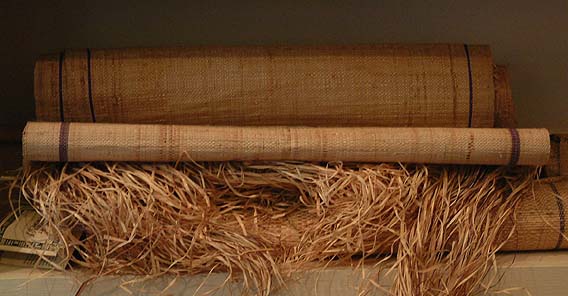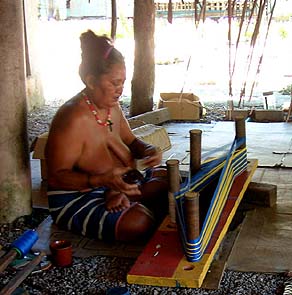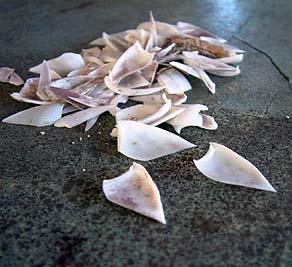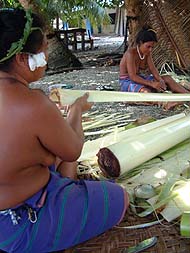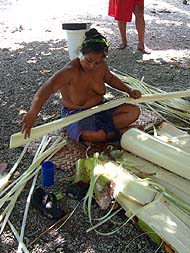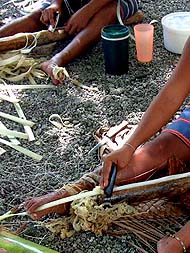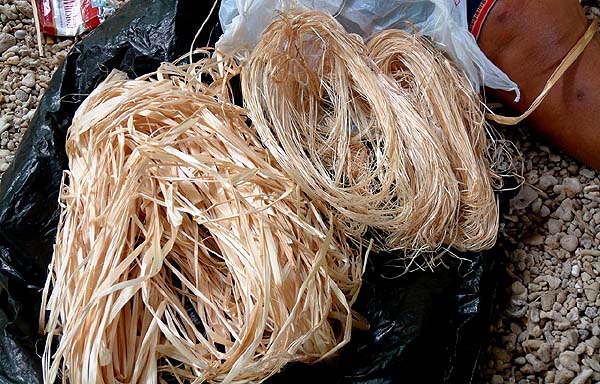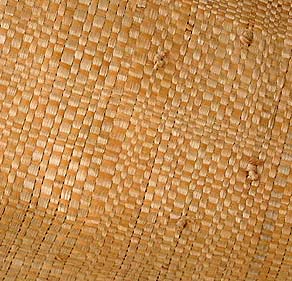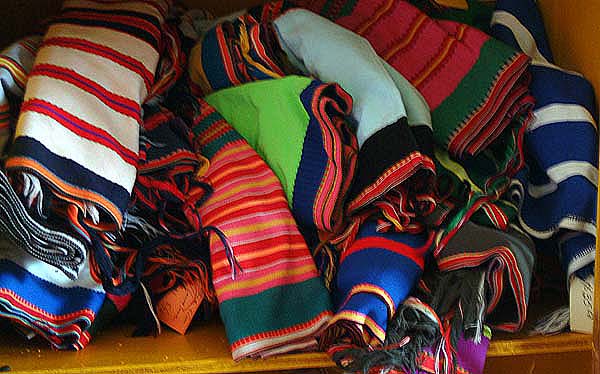Making Lavalavas:
|
“One must make sure the daughter knows how to weave a lavalava,” says Eli Lerang, Culture teacher at Mogmog Elementary. “Because it is worn, as well as the main medium of exchange.” “It’s a source of shame for our ladies here to buy lavalava,” Mariano adds. “If you have a job, you have money, you can buy a lavalava in the store to use as a gift, or to give to a friend, but not to wear it, because women here, ‘well, look at her’—they start gossiping,—‘she can not make her own lavalava, now she’s buying in the store!’"
|
||
|
|
||
“The students have to start up with learning lavalava weaving,” Mariano continues, “meaning sitting at the loom. To learn how to start the lavalava weaving they can start up with the commercial threads. Once they can do weaving, then they can move on to the more complicated, local-fiber kind. “Traditional lavalava requires making the right type of fiber, treating the fiber, slicing the fiber to thin strip like the commercial threads. But by that time they’ve already learned how to sit at the loom and how to start the lavalava on the loom from the easier commercial threads. So it will be easier for them to deal with. "And when they know that, then they can move ahead, because the fibrous lavalava is a more complicated task. They have to go through many processes in order for the material to be actually ready for the loom."
|
|
|
“In the process for making the fiber, banana fiber," Mariana Chim explains, "first you cut the banana tree, and then you peel off the outer edge. The stem of the tree is like many sides put together. So you would tear off one side and peel off the outer skin. The bark is soft. So it’s the outer, tough skin that you peel off in strips. Peel it off in strips until you come to the core, which is very soft. You cannot peel it anymore. “Those strips that you have peeled, we will put each strip on a piece of wood or a branch, a cut branch, and then we scrape the inside until that leaves the outer side. And it becomes very thin but tough. Then you dry it in the sun. It takes a long time. Depending on what the weather. During dry season you could have them dry in a very short period."
|
|
|
|
|
|
|
|
|
||
“When it’s dry, then you cut it into strips. There are barnacles that grow on things, we usually get them when a log that has drifted onto the beach. It washes up on the beach, and you get the barnacles. When you open up the barnacles, you have two sharp knives for cutting the bark into very thin strips. Then they tie them together."
|
||
|
|
||
“Processing hibiscus fiber is similar to the banana. You’ve got the hibiscus branch. You pull, peel off the skin, and then you put it in the ocean for a certain time, and when you take it out it’s only the fiber, because all that other stuff would be washed away. "How long, it varies. It’s probably up to individual knowledge of how to do it, because some people can leave it in the sea water for only four days. And some leave it for a week. And probably if you pick the young ones, maybe those are the type that you just keep in the water for like four days. The harder ones can be left there for quite some time."
|
|
|
“Today mostly the commercial threads are being used. It has to do with easier process, without going through the processing of the traditional fiber before the loom set. The local-fiber kind is still woven, because it is higher, in terms of value, than those of commercial thread. "Each family has to have some local-material ones in place, so that when a very loved one gets into an exchange, or passes away, it is of these higher-value ones that need to be shown, to be placed on this person. That’s when people can see these, because you can not see them just anywhere, they are kept for this kind of very, very special occasion."
|
“They are seldom worn, because the softness of the commercial thread is preferred. So wearing the commercial thread is more comfortable. Ladies would like to wear the traditional kind on occasion, but then they have to keep it for this very special occasion, like a death in the family. So they tend to wear those of the commercial threads.” The culture teachers at each school teach how to weave this local fiber, because the children must learn how to weave the local fiber. What is taught at the elementary level is the preparation of the fiber. The actual weaving is usually done at the high school level with the older girls."
|
|
|
|
|
|
"Upon completion of each lavalava, it is sent to their central office in Yap and that’s where it’s placed on market. You will find some local fiber lavalavas in there. These are recorded, and the money from their sale goes into the account of that particular school." "These people are turning back to the local fibers," Mariana Chim says, "because they’re putting them up for sale, and people’s demand for these local fibers have been going up."
|
||
|
|
||
|
|||||
|
|||||
